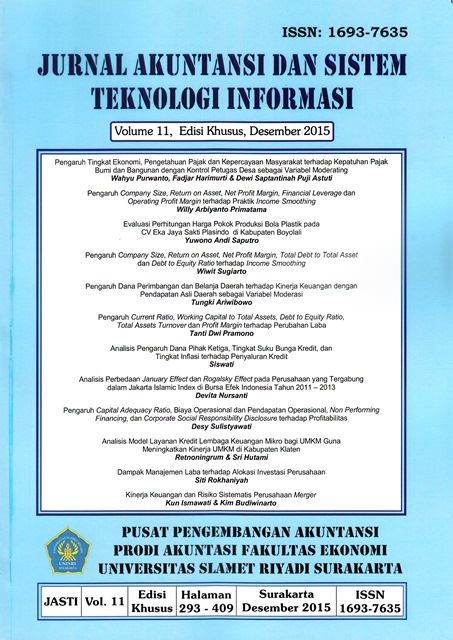ANALISIS PERBEDAAN JANUARY EFFECT DAN ROGALSKY EFFECT PADA PERUSAHAAN YANG TERGABUNG DALAM JAKARTA ISLAMIC INDEX DI BURSA EFEK INDONESIA TAHUN 2011 – 2013
Abstract
January effect and Rogalsky effect is one of market anomaly that could occur in the capital market. January effect is a condition in which return in January tend to be higher than average returns in other months of the year. Rogalsky effect is a phenomena where negative returns at Monday effect to disappear on specific month. The purpose of this analysis was to determine the difference between stock return in January and returns of months other than January and analysis was to determine the difference between stock return in April and returns of months other than April. The population in this study are all companies listed on the Jakarta Islamic Index in the Indonesian Stock Exchange in 2011 until 2013. Of the 30 companies listed in the Jakarta Islamic Index a sample of 11 companies. The analysis technique used was purposive sampling method. Analysis technique used is One Way ANOVA test. Results shows that there are no difference between returns in January and returns of months other than January and no differences between returns in April and returns of months other than April in the Jakarta Islamic Index. It can be concluded that in the Jakarta Islamic Index January effect and Rogalsky effect does not occur. Keywords: january effect, Rogalsky effect, stock returnsDownloads
Published
2016-01-13
Issue
Section
Artikel
License
Authors who publish this journal agree to the following terms:
- Authors retain copyright and grant the journal right of first publication with the work simultaneously licensed under a Creative Commons Attribution License that allows others to share the work with an acknowledgement of the work's authorship and initial publication in this journal.
- Authors can separately make additional contractual arrangements for non-exclusive distribution published by the journal (e.g., publish it in a book), with an acknowledgement of its initial publication in this journal.
- Authors are allowed and encouraged to send their work via online (e.g., in the institutional repositories or their website) after published by the journal.










